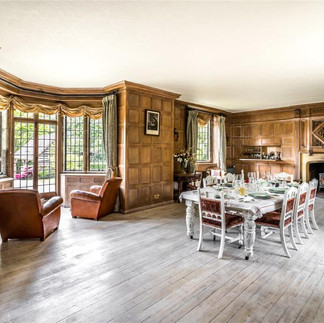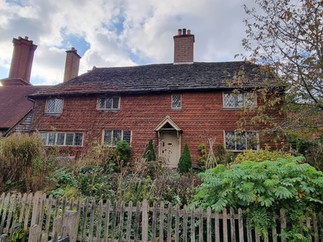The Arts and Crafts Movement
- Tiffany Snowden

- Mar 2, 2022
- 4 min read
Updated: Mar 3, 2022
Something that is often surprising to visitors to Britain’s towns and cities is quite how much of it is actually a Victorian pastiche of medieval architecture, even beloved landmarks that appear original to the untrained eye. York’s city walls, St Albans Cathedral’s magnificent frontage, and Bath Abbey’s fan-vaulted ceiling all owe a huge amount to the creative intervention of Victorian architects who wanted to restore them to something beyond their original appearance. The scale of this meddling was enormous, and it is estimated that around 80% of parish churches in England and Wales were ‘improved’ in this way in the 19th century.
While much of this work was done in a genuine attempt to preserve the building for future generations, little thought was given to the actual provenance of this re-building, with some additions relying on guesswork or simply the fancies of the architect rather than historical research. Square-towered Saxon churches with gothic spires thoughtlessly added still abound, while many original fonts pre-dating the Norman Conquest were replaced purely because they didn’t match later Tudor additions. Not all of this work was of good quality, either, and cost cutting led to high-quality but worn woodwork and stonework being replaced with inferior but newer reproductions that better matched the designers’ tastes.
Particularly upset by this trend were English polymaths John Ruskin and William Morris, who vigorously opposed the general trend away from artisanship and towards mass production. To them, the replacement of genuine craftsmanship with cheap, gaudy knock-offs was emblematic of the evils wrought by the industrial revolution. While poorer people were out of their hovels and into brick houses, and eating from plates rather than bowls made of bread, their lives were now sanitised and uniform. Rows of identical terraces, backing onto each other for square miles, with every inch of greenery erased; identical cupboards packed full of identical crockery, churned out by the same factories; everything optimised to be as similar and as cheap as possible, until anything resembling artistry or invention was removed from the lives of the working classes: a comfortable but sterile world.
Emboldened by the growing Socialist movement that aspired to something more than bare survival for the working classes, Morris and Ruskin and others like them began to do things differently. Their ultimate aim was to move the standards of design and craftsmanship away from the uniform, where everything was either artificially plain or artificially gaudy, and towards something more authentic. This was a movement that involved not just architects and planners, but also artists and designers, metalworkers and potters, illustrators and painters, glaziers and carpenters. It was so wide-ranging that it came to be known as simply Arts and Crafts, and its major tenet was that everything in a building should be thoughtfully created to contribute to the larger whole.
Generally led by one virtuoso architect, the building’s design should be informed not by the budget or the changing fashions of the day but by local traditions and materials. Instead of sprawling, empty mansions, housing should be utilitarian, with a layout of rooms that serve a purpose, gathered around an imitation medieval hall as the focal point. Every tiny detail from light fixtures to floorboards, bricks, tiles, glass and wallpaper, should be chosen for its contribution to the aesthetic of the whole house. And, most importantly, each and every one of these elements should be handmade by craftsmen trained in their creation, rather than churned out of a factory. Ornamentation was the order of the day, and anything that could elevate the house beyond the bare minimum was valued, resulting in splendid expanses of plasterwork on walls and ceilings, as well as beautifully carved skirting boards and hand-crafted doors, handles individually beaten in wrought iron, acres of stained glass, and bricks laid in inventive patterns reminiscent of Tudor fashions. The Arts and Crafts house could be small but perfectly formed, and a simple terrace made beautifully was worth more than any number of mass produced period McMansions.
Overall, the movement had mixed success. Up and down Britain, the style flourished in the hands of the middle classes, and while the most famous Arts and Crafts houses tend to be grand piles such as Cragside in Northumberland, Goddard’s in York, the Glasgow School of Art, and Standen House in West Sussex, many of its ideas trickled down to more modest housing all over the UK. Developments such as Salts Mill and New Earswick in Yorkshire greatly expanded the ambition of what the average person could expect from their home and community, introducing quality design and materials as well as green spaces, gardens, community facilities and amenities. Middle class homes across the land sported high-quality local features such as bargeboards and hung tiles in the south, flint walls and checkerboard patterns in East Anglia, mullioned windows and sandstone tiles in the north, and artful stained glass in Scotland.
However, despite its initially radical aims, the Arts and Crafts movement was held back ultimately by its conservatism. The founding fathers of the ideology complained that, despite the populist ideals it began with, due to the cost of creating a truly Arts and Crafts house, the vast majority of commissions were being built for the wealthy. It had largely abandoned its original Socialist principles and was simply another fashion statement to be bought by rich families, while the working classes saw little of the movement’s fruits. This apparent failure made it a rich nursery for the Modernist movement, and many later Arts and Crafts craftspeople straddled both camps, such as Scottish designer Charles Rennie Mackintosh, seeking to alter design philosophy more radically than had been achieved before.
Ultimately, the Arts and Crafts movement is something that, appropriately, survives best in what it made rather than what it believed. As an architectural style, it is a footnote sandwiched between the Revivalists and the Modernists, too subtle to replace the former and too timid to fight the latter, but it created some of the most beloved and high-quality art and architecture of the Victorian period. It’s hard to say if William Morris would be pleased or outraged that, today, we often mistake his loving copies of what went before for the real thing.



























Let's make your home a masterpiece! Our professional home interior design services are all about crafting a space that not only looks incredible but also feels perfectly you.